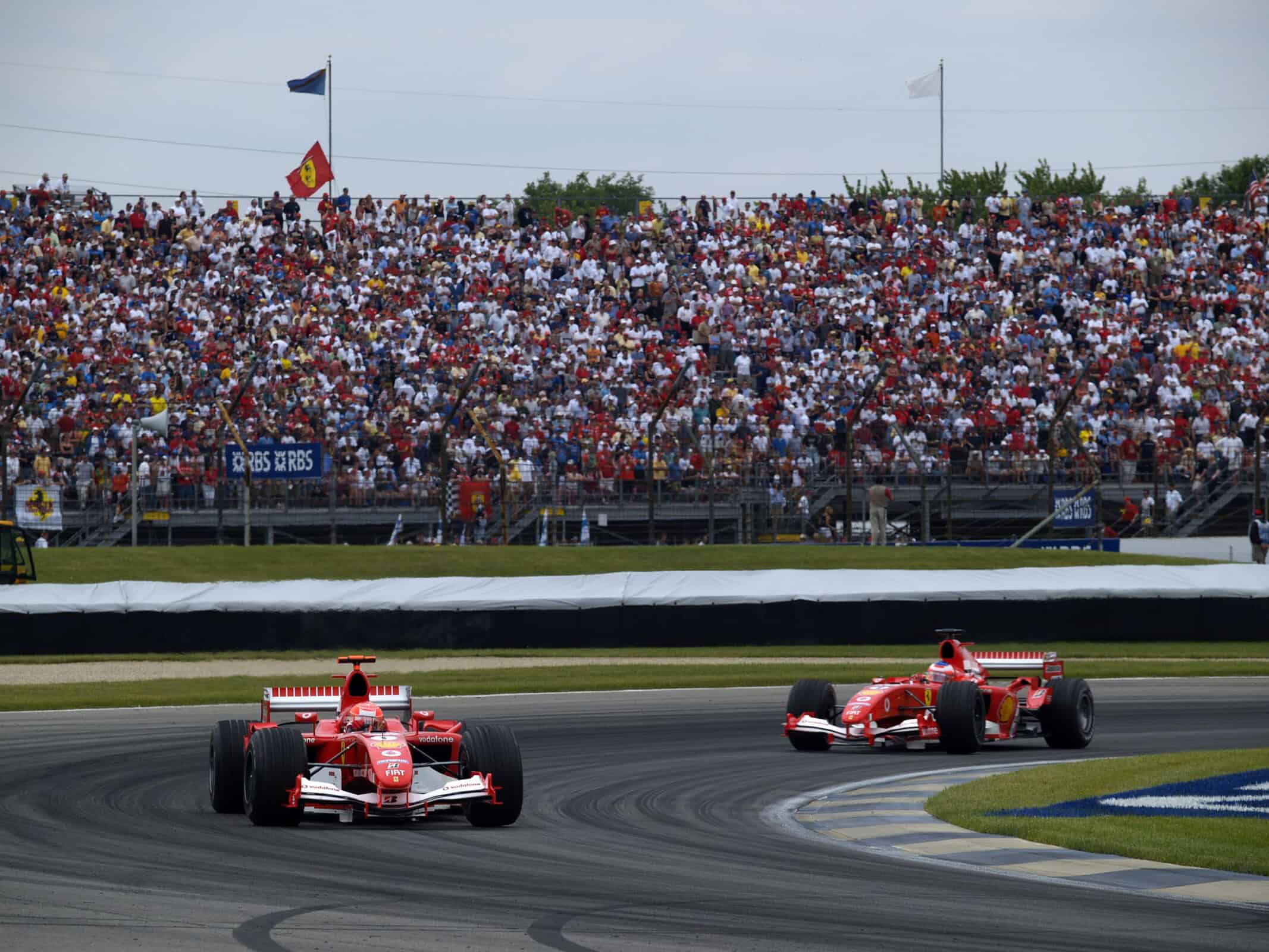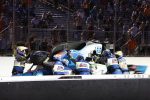Exactly 20 years ago, on June 19, 2005, only six cars were present for lights out at the start of the 2005 United States Grand Prix at Indianapolis Motor Speedway, following a formation lap featuring the full 20-car field. It would be strange if 14 cars just disappeared into thin air; what would be even stranger is the true, remarkable story of why those 14 cars didn’t take the start of the race. The infamous race remains one of the most unique and bizarre events in Formula 1 history.
The start to the 2005 USGP from the American SPEED Channel perspective. David Hobbs and Derek Daly let 'em have it. pic.twitter.com/6qIKAWndOR
— Nathan 😀👍 (@KensethFan17_20) April 19, 2025
First, a little backstory. In 2005, F1 rules stated cars could only use a single set of tires for both qualifying and the race. Currently, F1 has one tire supplier: Pirelli. In 2005, there were two suppliers: Bridgestone and Michigan. At the time of the 2005 U.S. Grand Prix, the top four teams in the constructors’ standings were all using Michelin, which had established itself as the best tire.
The bizarre chain of events started on Friday, June 17, when, during a practice session, Toyota driver Ralf Schumacher, running on Michelins, blew a left-rear tire and crashed hard in turn 13, which in the Indianapolis Motor Speedway F1 layout was a high-speed, banked turn (turn 1 in the Indianapolis 500), the only one of its kind at the time in F1. The combination of speed and banking created a load that the Michelin tires, particularly the tire walls, the Toyotas were running, could not withstand.
Oddly enough, Schumacher suffered an eerily similar crash in the 2004 United States Grand Prix, also due to a left-rear tire puncture.
While Schumacher’s teammate Jarno Trulli did not crash in the 2005 practice session, the Toyota team noticed alarming issues in the left rear tire, particularly what looked like vertical cuts in the tire wall. On Saturday, Trulli won the pole for Sunday’s race, but with Michelin unable to guarantee a safe tire for the race, Trulli had no chance of cashing in the pole.
Michelin engineers initially suspected the problem could have been that the Toyotas were running tires with under-inflated pressures. But Toyota was running perfectly normal tire pressures, leaving Toyota and Michelin baffled as to why only Toyota was experiencing the issue.
The problem became a more serious one when it was discovered that the Michelin tires on other teams were showing similar issues. Suddenly, the idea that there would be a totally normal U.S. Grand Prix was in jeopardy.
In a Saturday meeting, the Michelin teams suggested a chicane be added before turn 13 to slow the cars down, thus reducing the stress on the tires. With F1 executive Bernie Ecclestone and Indianapolis Motor Speedway CEO Tony George seemingly on board with the proposal, it appeared that a potential solution was in the works. However, when asked to recall the situation in a 2015 interview, FIA race director Charlie Whiting said the chicane idea was never seriously considered, mainly for logistics and safety concerns. Whiting stated it wasn’t possible, given the extremely short time frame, to properly test and simulate the chicane and be confident in its safety.

F1 Review: George Russell Tops Max Verstappen To Win in Canada; Lando Norris Tags Teammate and Wrecks
In a last-gasp effort to investigate the tire issue, Michelin flew a random selection of their tires to their research and development center in Akron, Ohio. There, the tires were subjected to a variety of tests, but nothing new was learned that would remedy the problems.
As the race the next day on Sunday loomed, several so-called “solutions” were lobbied, with few gaining little, if any, traction. One idea was to institute a speed limit through turn 13, possibly using an adjusted pit limiter. Another was to lift the one-tire rule and allow unlimited tire changes.
Other seemingly less practical ideas included running the cars through the pit lane on every lap, thus avoiding turn 13, or imposing a speed limit for just the Michelin teams, while the Bridgestone teams would lap at normal speeds. All were ultimately discarded.
Then, the chicane idea again was reintroduced, with Ecclestone apparently spearheading the idea in a Sunday morning meeting attended by Ecclestone, Tony George, Michelin executives and the team principals of nine of the 10 teams, with Ferrari’s Jean Todt refusing to attend. Todt’s position was that the situation was for the FIA and Michelin to decide, and none of Ferrari’s concern. And maybe Todt was secretly hoping for a race with just six cars and a much better chance of a win for Ferrari, who were winless in the first eight races of the season.
That idea again was shot down, with FIA president Max Mosley tersely saying the FIA would not sanction the race if the track layout was changed in any way. Mosley’s stance was that racing with an altered layout would open the FIA up to the threat of lawsuits should anything go wrong.
Then, the idea of making the event a non-championship race, with no points awarded at all, was the next on the agenda. Nine of the 10 teams agreed to this proposal, with all nine agreeing to proceed and race even if Ferrari chose not to. This would, of course, go in opposition to Mosley’s stance, so if the race proceeded, it would have to do so without FIA sanctioning.
With the proposal gaining traction, replacements for FIA-held positions, such as Whiting’s race director position, were being discussed. But it never materialized, mainly because finding replacements for the many FIA technical positions was a logistical nightmare. And without proper technical positions filled, it would be virtually impossible to enforce regulations. One idea floated was to race without technical directors and hope that teams would follow the rules on the honor system. The plan failed to materialize, as “Honor system” and ”Formula 1” are phrases that simply can’t be used in conjunction.
Eventually, the Michelin teams decided they would not start the race, and then took to persuading their drivers to comply. The drivers agreed, but still, many started the formation lap not exactly sure what their fellow Michelin-tired competitors would do. Renault’s Fernando Alonso was in a tight championship battle with McLaren Mercedes’ Kimi Raikkonen. Raikkonen was starting second on the grid, while Alonso qualified sixth. As Alonso stated years later, “I had the instruction if he goes to the grid, you go to the grid, if he goes to the pit lane, you go to the pit lane. We had all agreed to go to the pit lane, but in case Kimi changed his mind at the last moment, I had to do the same! So there was some stress on that formation lap.”
While fans in attendance, which reportedly numbered close to 130,000, likely had some idea that something was amiss, they certainly didn’t expect to see 14 of the 20 cars in the field park in the pit lane, especially after completing the formation lap.
The six cars of the Bridgestone-shod teams (Ferrari, Jordan, and Minardi) took their place on the grid, all guaranteed to score points (in 2005, F1 employed a 10-8-6-5-4-3-2-1 points system).
Some fans were mystified, some were furious, some were both. Many left and headed for the IMS ticket office to demand refunds.
Angry fans being interviewed during the 2005 USGP. pic.twitter.com/rJF8PZNqxY
— Nathan 😀👍 (@KensethFan17_20) November 17, 2023
As one would expect, the action in the race was limited, save for a moment when Ferrari’s Michael Schumacher forced teammate Rubens Barrichello into the grass as the two teammates changed into turn 1 on lap 51. Ultimately, Schumacher and Barrichello finished 1-2, with the Jordans of Tiago Monteiro and Narain Karthikeyan taking third and fourth, respectively, and more than a lap down. The Minardis of Christian Albers and Patrick Friesacher finished fifth and sixth, respectively, over two laps behind the Ferraris.
In perhaps the most subdued podium celebration in history, Schumacher and Barrichello duly listened to the German national anthem, accepted their trophies, and left with unopened champagne bottles. As hollow victories go, this one was as hollow as a Max Verstappen apology.
On the other hand, Monteiro partied like he’d never been on a podium before, and would never be on a podium again. And he was right to do so, because Indy was his only career podium, and the first podium for a Portuguese driver.
#OnThisDay in 2005:
— Formula 1 (@F1) June 19, 2017
Tiago Monteiro became the first and only Portuguese 🇵🇹 driver to secure a podium finish in #F1 at the #USGP pic.twitter.com/MnHSahAawD
In the aftermath, the teams that ran Michelin tires issued a joint apology to fans and sponsors, and Michelin refunded some ticket holders for the event. While many faulted Michelin for their inability to provide an adequate tire, others hurled culpability at the FIA for their stubborn unwillingness to find any compromise whatsoever. The FIA and Michelin lobbed criticisms back and forth. The FIA had no jurisdiction to punish or penalize Michelin, since they were not a competitor, but did convince Michelin to agree to a compensation package, which included the purchase of tickets for the 2006 United States Grand Prix.
The FIA did have the power to punish the seven Michelin teams for opting not to race, and all were ordered to face a World Motor Sports Council hearing. All seven were charged with the following: failing to ensure that they were in possession of suitable tyres for the 2005 US Grand Prix; but with strong, mitigating circumstances, of wrongfully refusing to allow their cars to start the race, having regard to their right to use the pitlane on each lap.”
Three other charges were dropped, most notably “refusing to race subject to a speed restriction.” Legally, teams that would have raced knowing they had a tire defect would have been responsible for criminal negligence under the state laws of Indiana. So, wisely, the FIA didn’t punish teams for their refusal to race, even with the speed restriction, as the teams made the decision from a safety, and legal, standpoint.
In addition to the fans’ displeasure with the race, the numerous sponsors of the seven Michelin teams were rightly miffed as well. Those sponsors plastered those cars with advertisements and logos, expecting a live Indy crowd and a worldwide television audience to see them on more than just a formation lap. On the other hand, the sponsors of the six cars that raced got their money’s worth and then some.
The 2005 debacle at Indianapolis left F1’s reputation in the United States damaged, and many questioned whether another grand prix would be held at Indy. But the 2006 version was held, with Michael Schumacher winning the race that featured a full field and no tire controversy. 2006 also marked Michelin’s final year in F1. Lewis Hamilton won in 2007 in what was, to date, the last United States Grand Prix held at Indianapolis.
2007 #OnThisDay June 17, Lewis Hamilton won the United States Grand Prix in Indianapolis ahead of his McLaren teammate, Fernando Alonso, who, as the season progressed, had become increasingly unsettled by Hamilton’s success. Ferrari driver Felipe Massa completed the podium by… pic.twitter.com/Ps0IRkO5uE
— Formula One History (@F1History1950) June 17, 2025
After the 2007 race, the Indianapolis Motor Speedway and F1 could not agree on terms for a 2008 race. What positive foundation was built on the 2000-2004 races came crumbling down in 2005, never to be recovered.
The United States Grand Prix returned to the Americas in 2012 in Austin at Circuit Of The Americas and has been there ever since, save for the COVID cancellation of the race in 2020. While F1 hasn’t ruled out a return to Indianapolis, the infamy of the 2005 would appear to be the biggest obstacle to a potential return.



